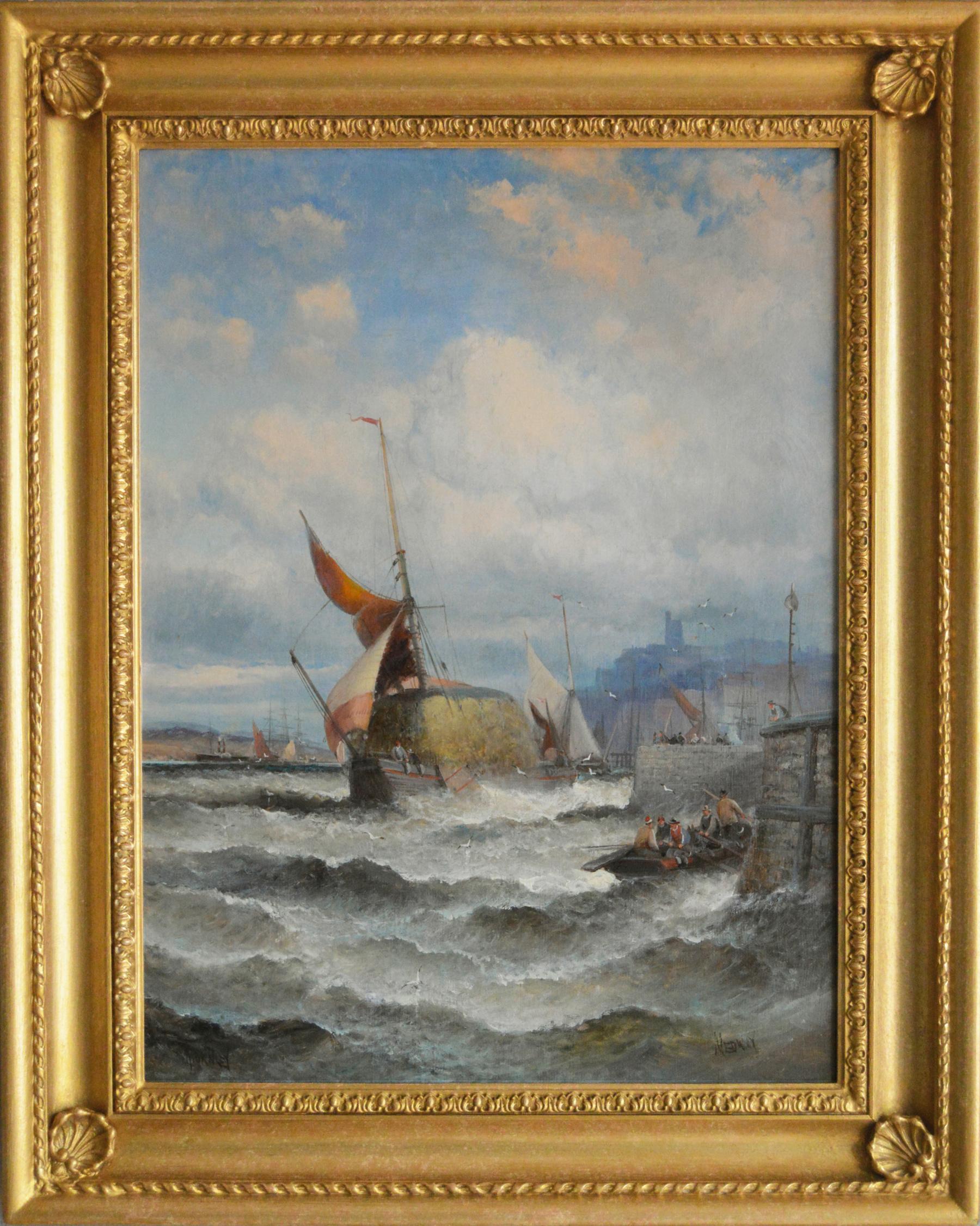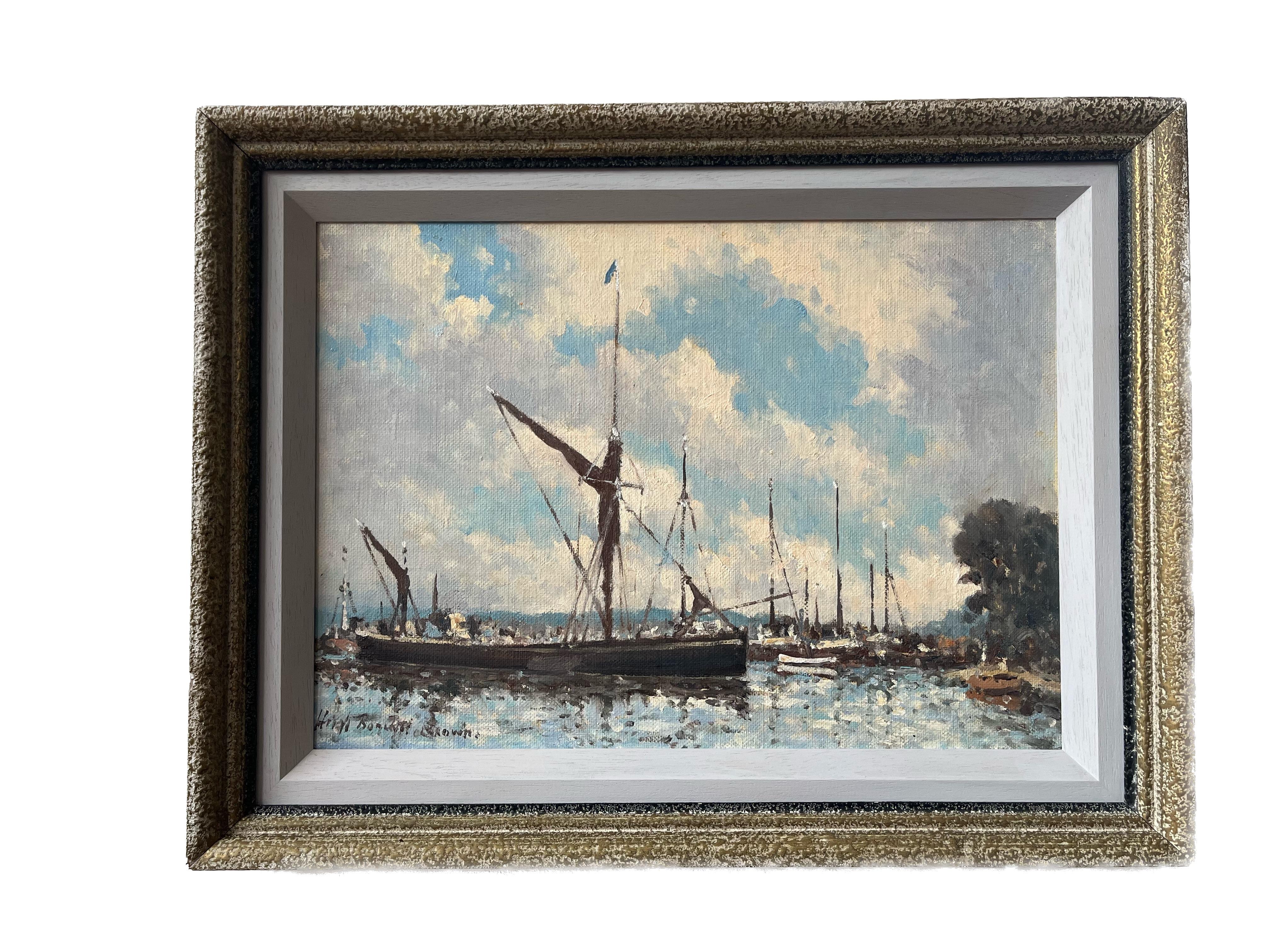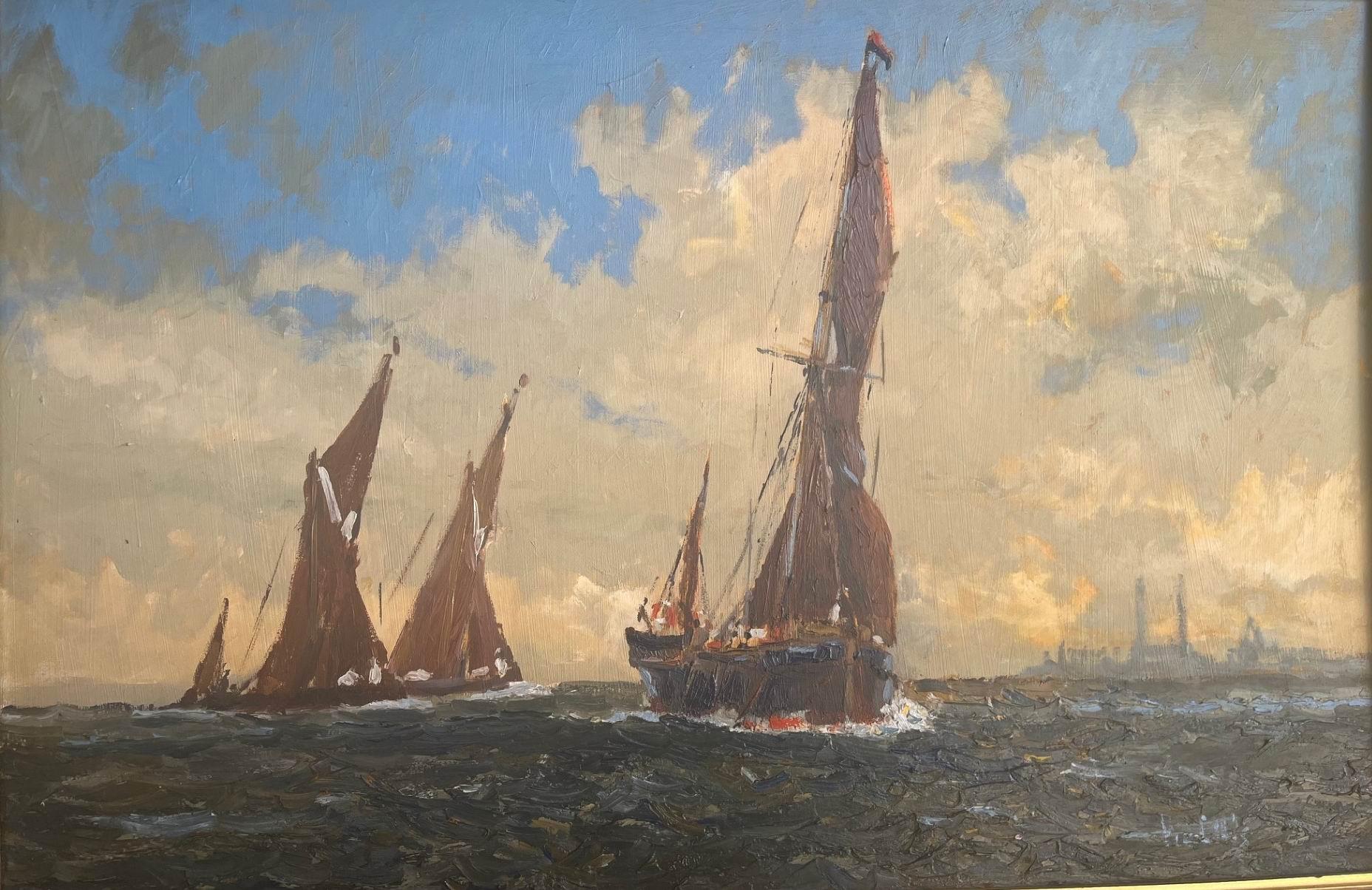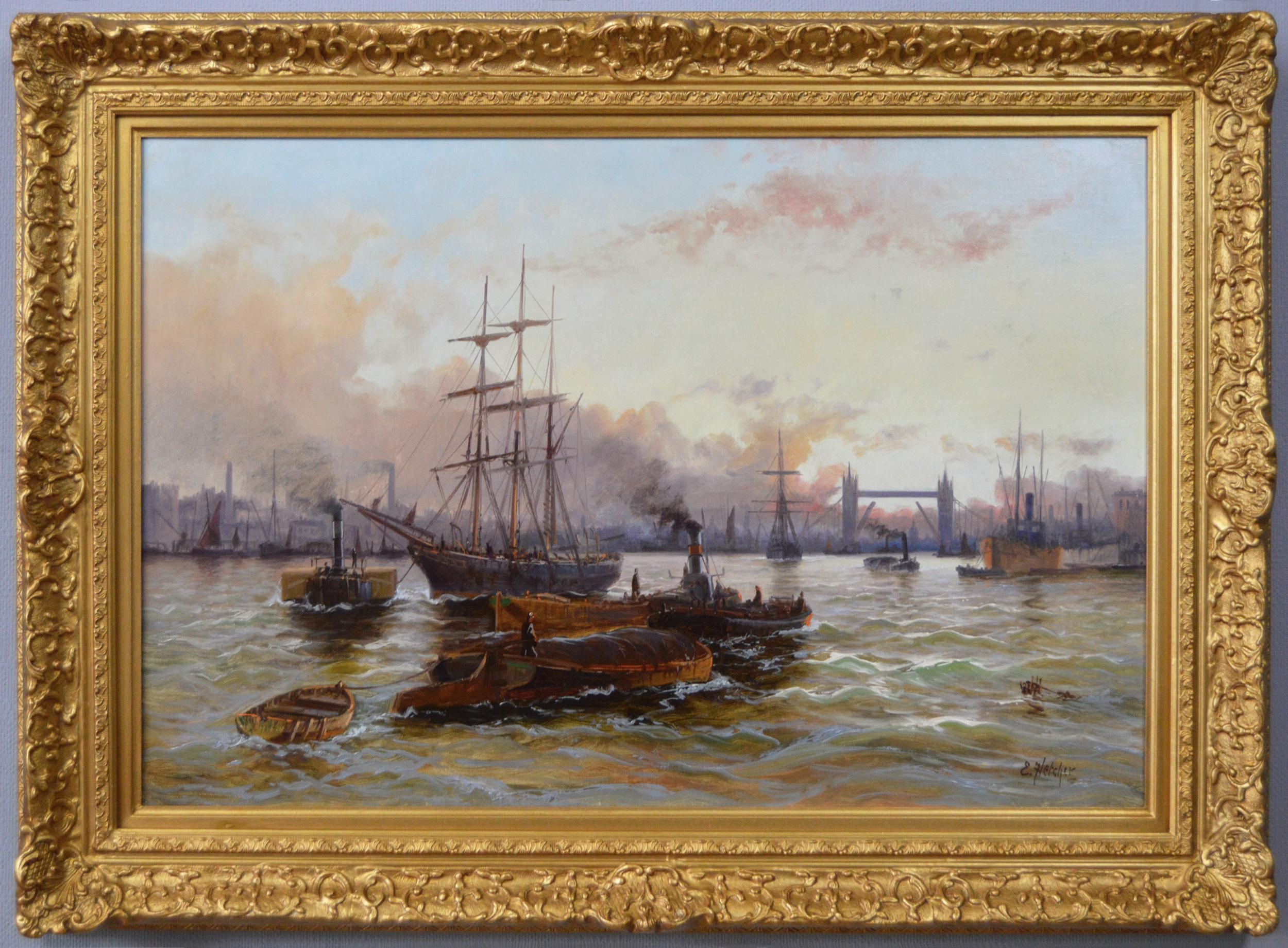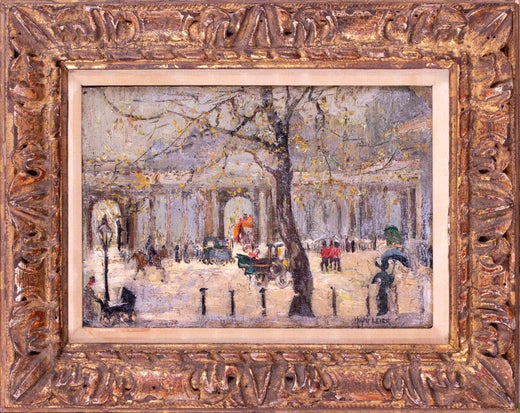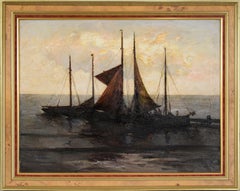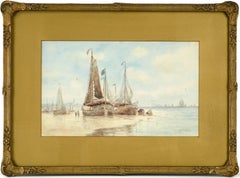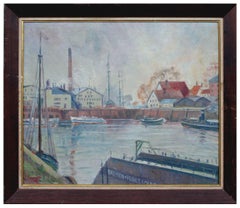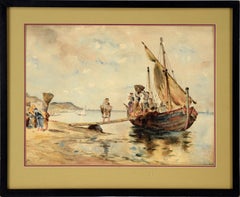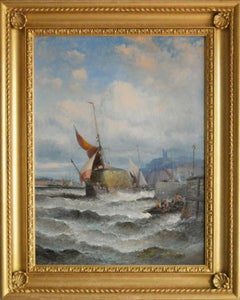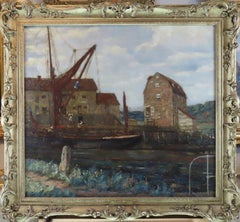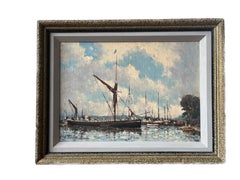Items Similar to "Straw Barge" on the Thames (after) Edward Duncan Oil on Linen 1898
Want more images or videos?
Request additional images or videos from the seller
1 of 13
Richard Hayley Lever"Straw Barge" on the Thames (after) Edward Duncan Oil on Linen 18981898
1898
$4,672
$7,50037% Off
£3,581.68
£5,749.7037% Off
€4,098.45
€6,579.2837% Off
CA$6,602.59
CA$10,599.1937% Off
A$7,176.75
A$11,520.9037% Off
CHF 3,841.83
CHF 6,167.3237% Off
MX$86,750.30
MX$139,260.9737% Off
NOK 48,414.56
NOK 77,720.2937% Off
SEK 44,650.80
SEK 71,678.2937% Off
DKK 30,608.87
DKK 49,136.6837% Off
About the Item
"Straw Barge" on the Thames (after) Edward Duncan Oil on Linen 1898
Well executed study of E. Duncan's Straw Barge circa 1881, painted by Richard Hayley Lever dated 1898 a year before he went to England, where he proceeded to refine his skills as a painter under the tutelage of the British impressionists Julius Olsson and Algernon Talmage. Duncan's sketch and color plate of the Straw Barge painting was used in the book SIMPLE LESSONS IN WATER COLOR , Marine painting. Hayley Lever used that example to paint his interpretation of "Straw Barge" in 1898. Lever attended Adelaide's Prince Alfred College from 1883 to 1891, during which time he received drawing lessons from the marine painter, James Ashton. As a boy, he loved to watch incoming clipper ships at the port of Adelaide, an experience that influenced his later penchant for maritime themes. Upon graduating from Prince Alfred College, he took classes with Ashton at the Norwood Art School and later attended Ashton's Academy of Art in Adelaide.
Oil on linen in a 20th century walnut frame with linen liner. From a Bay area collection estate.
Signed lower left "H Lever 1898"
on verso "Straw Barge" "Hayley Lever" (partially indistinguishable see images)
Image, 17"H x 22"W
Frame, 21"H x 26"W x .5"D
Hayley Lever's exceptional career path took him from the shores of his native Australia to those of England, and then the United States.[1] Described as an artist of "individuality,"[2] he refused to ally himself with any particular style or movement; rather, guided by his belief that "art is the re-creation of mood in line, form and color," he incorporated the precepts of Realism, Impressionism, Tonalism and Post-Impressionism into his art, applying those strategies in accordance with the emotion and aesthetic affect he wished to convey.[3] In America, where he achieved his greatest acclaim, he was viewed as a proto-modernist, lauded by critics such as Edgar Holger Cahill, who declared:
"in all his painting, whether it is of boats dancing on the waters of the Cornish coast, the ferry bridges and boats and streets of Gloucester, Massachusetts, the steaming asphalt highways of New York City, or the gently upheaving Catskills about Woodstock, it is always Lever who addresses us.[4]"
Hayley Lever was born on September 28, 1875 in Bowden Tannery, a suburb of Adelaide, Australia.[5] The son of Albion W. Lever and his wife, Catherine (Hayley) Lever, he was christened Richard, but as a professional artist he used his second and last names only.
Lever attended Adelaide's Prince Alfred College from 1883 to 1891, during which time he received drawing lessons from the marine painter, James Ashton. As a boy, he loved to watch incoming clipper ships at the port of Adelaide, an experience that influenced his later penchant for maritime themes. Upon graduating from Prince Alfred College, he took classes with Ashton at the Norwood Art School and later attended Ashton's Academy of Art in Adelaide. During these years, Lever spent his free time painting and sketching in the local countryside, exhibiting his work at the Adelaide Easel Club and at other local venues. His interest in painting outdoors was likely influenced, to some extent, by the achievements of artists such as Tom Roberts, Charles Conder and other painters of the so-called "Heidelberg School," who introduced the tenets of Impressionism and pleinairism to Australian art during the late 1880s and early 1890s.
A turning point in Hayley Lever's artistic evolution occurred in the autumn of 1899, when he sailed to England for further study. He initially went to London, studying the art of both the past and present in the city's galleries and museums. In early January of 1900, he settled in St. Ives, an ancient fishing port and art colony on England's Cornish seacoast, where he proceeded to refine his skills as a painter under the tutelage of the British impressionists Julius Olsson and Algernon Talmage. Working out of a studio located on the top floor of a local art gallery, he painted views of the town and harbor, as well as scenes of Devon. In keeping with the tonal impressionist proclivities of St. Ives painters at that time, he became especially interested in conveying evening effects, going on to paint atmospheric moonlight scenes with soft brushwork and a low-keyed palette. At the same time, Lever was also looking beyond St. Ives for inspiration. He continued to make trips to London and his proximity to the Continent allowed him to travel to Paris, where he familiarized himself with styles such as Impressionism and Post-Impressionism and exhibited his paintings at the Salon. Biography from Spanierman Gallery (retired)
Born in Adelaide, Australia, Hayley Lever was known for his town-shore landscapes and still-life painting in a style that combined impressionism with vivid colors and strong lines of realism---post impressionism. In his use of color, he was deeply influenced by Vincent Van Gogh. He freely explored numerous styles based on impressionism but was never locked into any particular style.
He showed early art talent and traveled to England in 1893. He studied art in London and then painted at an artists' colony in Cornwall on the seacoast of St. Ives where he began his seacoast paintings. He received much attention in Europe for these works. In 1908, he did a series of paintings called "Van Gogh's Hospital, Holland" expressing the profound influence he felt of that artist.
Lever came to America in 1911, encouraged by American artist Ernest Lawson whom he knew in France, and was soon counted among the most widely exhibited artists in New York City. Many of his scenes were of Manhattan. He had a summer studio in Gloucester, Massachusetts and from 1919 to 1931 taught at the Art Students League in New York City. He also became Director of the Studio Art Club in Mount Vernon, New York.
Lever imparted to his students the following message: "Art is the re-creation of mood in line, form and color. If I were confined to my own back yard for the rest of my life, I'd still have more pictures in my mind than I would have time to paint. Art is nothing but having a good time"
He died in Mount Vernon, New York in 1958, having suffered ill health the last few years of his life.
He received many awards and critical acclaim and his works were purchased by major American museums, such as New York's Metropolitan Museum of Art and Washington's Phillips Collection and Corcoran Museum. Source: Michael David Zellman, "Three Hundred Years of American Art"
- Creator:Richard Hayley Lever (1876-1958, American)
- Creation Year:1898
- Dimensions:Height: 21 in (53.34 cm)Width: 26 in (66.04 cm)Depth: 0.5 in (1.27 cm)
- Medium:
- Movement & Style:
- Period:
- Condition:Very good paint and finish with one 2.5" tear middle right side professionally restored and retouched and two small punctures repaired. (all reversable and minimal conservation methods employed.) See last image for pre-conservation condition.
- Gallery Location:Soquel, CA
- Reference Number:Seller: RJA82431stDibs: LU54211053842
Richard Hayley Lever
An Australian by birth, Richard Hayley Lever left his native Adelaide at the age of 17 to train as an artist in Europe, and his work soon won attention in London and Paris. In 1900 he was introduced to the St Ives Club by fellow Australian Louis Grier, and he married Aida Gale in the town in the same year. Working closely with Grier and with Julius Olsson he maintained St Ives as a base, while also painting marine subjects along the southern coast of England and in Brittany. In 1912 Hayley Lever move to New York and took American citizenship. His paintings of the Hudson Valley, Vermont, and Nantucket secured an international reputation.
About the Seller
5.0
Platinum Seller
Premium sellers with a 4.7+ rating and 24-hour response times
Established in 1986
1stDibs seller since 2014
3,052 sales on 1stDibs
Typical response time: <1 hour
- ShippingRetrieving quote...Shipping from: Soquel, CA
- Return Policy
More From This Seller
View All"Fishing Schooners and Sailboats at a dock" Original Oil on Canvas
Located in Soquel, CA
Fishing Schooners and Sailboats at a dock, "Fischerschoner und Segelboote an einem Dock" by Rudolph Guba (German/American, 1884-1950)
Impasto work which depicts several sailing ves...
Category
1940s Impressionist Figurative Paintings
Materials
Canvas, Oil, Stretcher Bars
Sailboats in the Harbor, Early 20th Century Figurative Landscape Watercolor
By Frederick Leo Hunter
Located in Soquel, CA
Wonderfully detailed early 20th century figurative landscape watercolor of sailboats docked on a bustling shore, surrounded by other boats, birds and men at work with carts, by Hudson Valley New York artist Frederick Leo Hunter (American, 1858-1943). The tall boats tower over two small figures, who wade into the water beside the vessels. In the background, a lighthouse and the hint of a skyline can be seen on the distant shore.
Signed "F. Leo Hunter" lower right.
Displayed in a gold mat and slender giltwood frame carved with a beautiful floral motif.
Image size: 7.5"H x 12"W.
Known for street scene paintings and etchings of New York...
Category
Early 20th Century American Impressionist Landscape Drawings and Waterco...
Materials
Paper, Watercolor
Boats in the Harbor - Mid Century Industrial Seascape
By Pieter Hashager
Located in Soquel, CA
Beautiful post war oil painting of boats navigating through the Bremen, Germany Industrial harbor by Pieter Hashager (20th Century). Signed and dated "P. Hashager '47" lower left. Di...
Category
1940s Impressionist Landscape Paintings
Materials
Masonite, Oil
Loading the Cargo Ship - Brittany France - Watercolor 19th Century
Located in Soquel, CA
French Coastal Scene in Brittany with a merchant ship onloading fish and people by an unknown artist. A sailing vessel is anchored at a beach. A r...
Category
Late 19th Century Impressionist Figurative Drawings and Watercolors
Materials
Watercolor, Postcard, Illustration Board
$1,320 Sale Price
20% Off
Late 19th Century Boats at San Francisco Port Seascape Drawing
By Raymond Dabb Yelland
Located in Soquel, CA
San Francisco moorings, a late 19th century double-sided pencil sketch by Raymond Dabb Yelland (American, 1848 - 1900), 1987. Signed "R.D. Yelland" lower right. Dated "87" lower left. Drawing on both sides of paper. Wood frame. Image size, 8.5"H x 12"L.
A master marine painter, Yelland painted in Gloucester Harbor. He sailed to San Francisco in 1874 to take a teaching position in art at Mills College in Oakland. From 1877 to 1894, he taught at the California School of Design. He was a decisive influence on a younger generation of California artists.
Full Bio:
Raymond Dabb Yelland was born in London, England on February 2, 1848. At the age of three, he immigrated with his family to New York City where he was raised and attended public schools. By the age of twelve, he had settled on art as a career.
He was born as Raymond Dabb, but due to the negative connotation of his name, his mother's maiden name, Yelland, was added. After serving under Sheridan in the Federal Army during the Civil War, Yelland attended Pennington Seminary in New Jersey. He studied art at the National Academy of Design from 1869 to 1871 with Page and Brevoort, and then taught at the Academy for one year.
With his new bride, he sailed around the Horn in 1874 to San Francisco where he would assume the position of an art instructor at Mills College in Oakland. In 1877, he traveled to England, and later continued his studies in Paris with Luc Oliver Merson. Upon his return to California, Yelland became assistant director of the San Francisco School of Design, and in 1888, assumed its directorship. While at that school, he also taught at the University of California, Berkeley, for many years. His many pupils included Homer Davenport, Alexander Harrison...
Category
1880s American Impressionist Landscape Drawings and Watercolors
Materials
Paper, Pencil
$1,836 Sale Price
20% Off
Boys in a Boat "The Admiral and 1st Mate" Going Down the River by Charles Harmon
Located in Soquel, CA
Boys in a Boat "The Admiral and 1st Mate" Going Down the River by Charles Harmon
Lovely early work of two boys in a boat going down a fast moving stream by Charles Henry Harmon (Ame...
Category
Late 19th Century Impressionist Figurative Paintings
Materials
Watercolor, Gouache, Laid Paper
You May Also Like
19th Century seascape oil painting of a hay barge on the Medway
By Hubert Thornley
Located in Nr Broadway, Worcestershire
Hubert Thornley
British, (exh. 1858 -1898)
Hay Barge on the Medway
Oil on canvas, signed
Image size: 23.5 inches x 17.5 inches
Size including frame: 30.5 inches x 24.5 inches
A fine...
Category
19th Century Victorian Landscape Paintings
Materials
Canvas, Oil
Oil Painting by Gordon A Meadows "Barnes on Thames"
Located in Mere, GB
Oil Painting by Gordon A Meadows "Barnes on Thames" Gordon A Meadows 1868 - 1935 was the son of Arthur Joseph Meadows. Oil on canvas. Signed and dated 1905. Oil on canvas.
Dimensio...
Category
Early 1900s Landscape Paintings
Materials
Oil
$2,659 Sale Price
20% Off
Original Oil on Canvas. Walter J. Hall, "The Maize Barge, Woodbridge"
Located in Mere, GB
Walter J. Hall. (1866 - 1947). Son of a Nantwich historian, painter of local Bury and East Anglian views, exhibitor at the Walker Art Gallery in Liverpool. Represented Bury and Nantw...
Category
Early 1900s Landscape Paintings
Materials
Oil
Hugh Boycott Brown, Impressionist view of boats at Pin Mill. Suffolk
Located in Harkstead, GB
A fluidly painted impression of this well known sailors' haven at Pin Mill on the River Orwell, Suffolk.
Hugh Boycott Brown (1909-1990)
Thames Bar...
Category
Late 20th Century Impressionist Landscape Paintings
Materials
Oil, Board, Canvas
$935 Sale Price
30% Off
Twentieth Century Marine Oil of Thames Barges on the Medway with power station
Located in ludlow, GB
Twentieth Century Marine Oil Painting of Thames Barges on the Medway with power station in the background by Vic Ellis.
Vic Ellis RSMA
1921 - 1984
Thames Barges and other Shipping....
Category
Mid-20th Century Impressionist Landscape Paintings
Materials
Oil
Riverscape oil painting of shipping on the Thames with Tower Bridge
By Edward Henry Eugene Fletcher
Located in Nr Broadway, Worcestershire
Edward Henry Eugene Fletcher
British, (1857-1945)
Shipping in the Pool of London at Dusk with Tower Bridge in the Distance
Oil on canvas, signed
Image size: 19.5 inches x 29.5 inches
Size including frame: 26.75 inches x 36.75 inches
An atmospheric painting of ships in the Pool of London at dusk by Edward Henry Eugene Fletcher. A variety of boats are depicted in the scene, including tug boats and barges. In the distance lies the iconic Tower Bridge. The Pool of London is a stretch of the River Thames between Tower Bridge and Limehouse and is divided into two sections, the Upper Pool and the Lower Pool.
Edward Henry Eugene Fletcher was a marine artist who was born in Marylebone, London on 23 July 1857 to Robert Henry Fletcher and Julia Pennell. His father worked for the Bengal Pilot Service guiding shipping along the Hooghly River between Calcutta and the Bay of Bengal. After the death of his father in 1862, his mother married the picture dealer Reuben Brooks. He attended the Bradmore House School in Chiswick Lane before enrolling at the Chelsea School of Art, where he became a close friend of the landscape artist Daniel Sherrin.
Fletcher initially enlisted in the Army Hospital Corp, serving in Nova Scotia but was invalided out in 1882 at the age of 24 due to an eye condition. His records indicate he was 6ft tall with fair hair and grey eyes. He continued to paint in his spare time and undoubtedly his travels would have inspired his subject matter and given him a deeper knowledge of shipping and the sea. He married Annie Reed Moses in 1886 at Norwich and they lived in Margate before moving back to London to live in Blackheath around 1890. He is widely believed to have set up an auction business during this time to help support his growing family, however , perhaps due to the return of ill health he decided to give it up to focus on painting.
Although he did not exhibit, he sold his work mainly through art galleries, possibly aided by his step father. He also used the pseudonym of John Hayes which was probably for contractual reasons. By 1901, he had established himself as a full time artist and was living at Georgette Place in Greenwich with his wife and their 5 children. He later moved to 99 Lee Road, Blackheath where he spent the rest of his life. He died at Blackheath on 23 June, 1945.
Much of Fletcher’s work consisted of views of the river Thames or ships in harbours...
Category
Late 19th Century Landscape Paintings
Materials
Canvas, Oil
More Ways To Browse
21 Club New York City
Linen Liners For Oil Paintings
Gloucester Massachusetts
Thames Painting
Thames Oil Painting
Barge Painting
Ferry Boat
Impressionist Painting Thames
Moonlight Scene
Clipper Watch
Haiti Art
Nude Italian Artist
Swim Paintings
Allegory Paintings
Master Copy
Red Haired Woman Oil Painting
Vintage Circus Painting
Cuban Artists Painting
